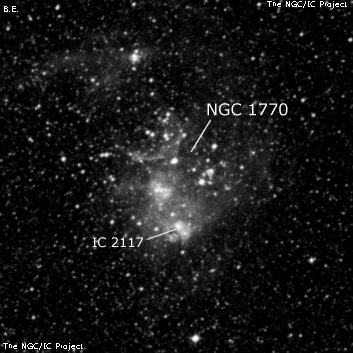
S-L 105, located 13' SW of NGC 1770, was observed using a 25" on 17 Oct 2017. It appeared moderately bright, fairly small, round, 30" diameter. Contains a relatively large bright core but there was no resolution. An additional 6' SSW is N86, a verified LMC supernova remnant. It was picked up unfiltered as a large, low surface brightness hazy region, just south of a mag 11.8 star. A couple of 14th mag stars appear involved with the haze. There was a weak contrast gain adding a NPB filter, with the most evident section ~1' diameter [centered 1.2' S of the mag 11.8 star] and slightly brighter on the east side.
James Dunlop discovered NGC 1770 = D 169 = h2715 with his 9" reflector and described a "pretty bright pretty large nebula, of an irregular round figure, 5' diameter; a little brighter in the middle." He made 2 observations and his position is accurate. John Herschel attributed the discovery to Dunlop and described the object on 23 Nov 1834 as a "cluster of 6th class; pretty rich, large, irregular figure, brighter in the middle; stars of 11..18th mag; fine object." On a second sweep he wrote "A star of 9th mag, the chief of a cluster of 6th class, 4' diameter; nebulous. The most condensed part is 1' south of the stars."
400/500mm - 18" (7/9/02 - Magellan Observatory, Australia): this LMC object is an interesting mix of a star cluster (OB-association LH 12) and an associated emission nebula (LMC-N91A = IC 2117), with the nebulosity mostly on the south side. A mag 10 star is near the center, along with a number of mag 11-12 and fainter stars. The stars are mostly on the north side of the nebulosity with several in small clumps.
600/800mm - 25" (4/4/19 - OzSky): at 244x; very impressive, bright nebulous cluster 5' in diameter. Unfiltered includes over two dozen stars from mag 11-14 with a few pairs. Most of the stars are on the north and west side and include an 11th mag star (HD 268804) near the center and another mag 11 star on the west side. The western component of a 9" pair of mag 12.6/13.2 stars on the north side is a Wolf-Rayet star Brey 10 (HD 32402). Two very bright emission knots with a total size of 2' are on the south side; the southernmost knot is IC 2117.
The entire field displayed a very strong response to a NPB filter with the nebulosity irregular and patchy and the two main nebulous patches on south side intensely bright. With careful viewing Brey 10 was surrounded by a very thin, dim arc (Wolf-Rayet bubble) of perhaps 150?, extending NW to SE of Brey 10 (opening to the NE) with a diameter of 1.5'. The SW edge of the arc was just north of (HD 268804. The arc was subtle and visible only intermittently.
Notes by Steve Gottlieb